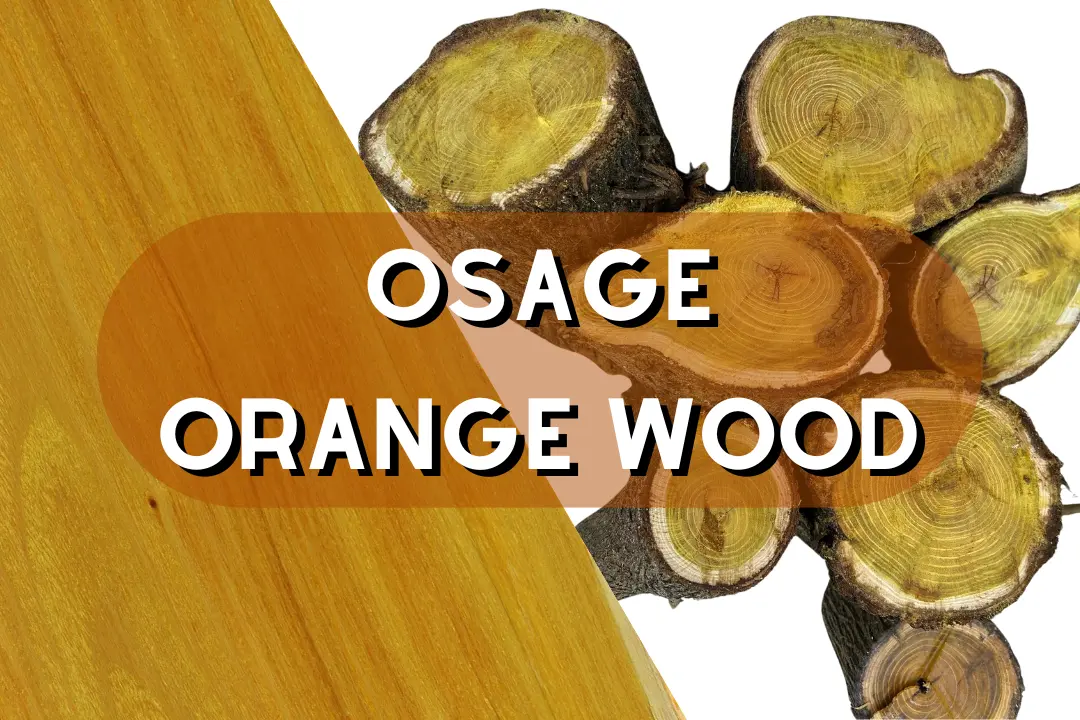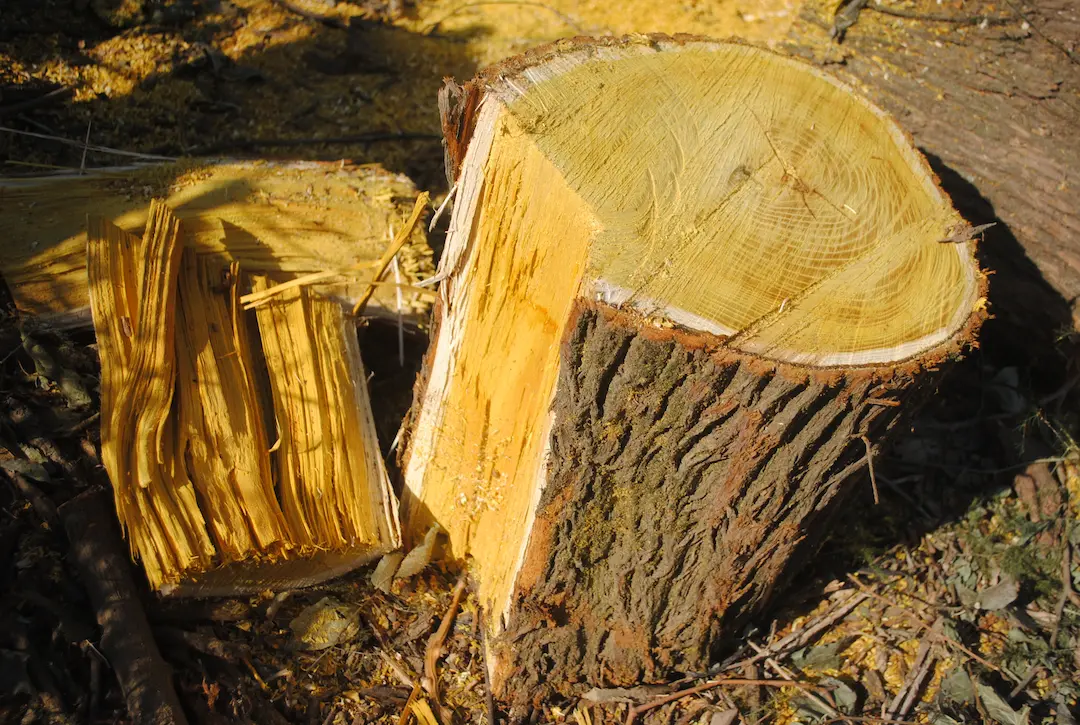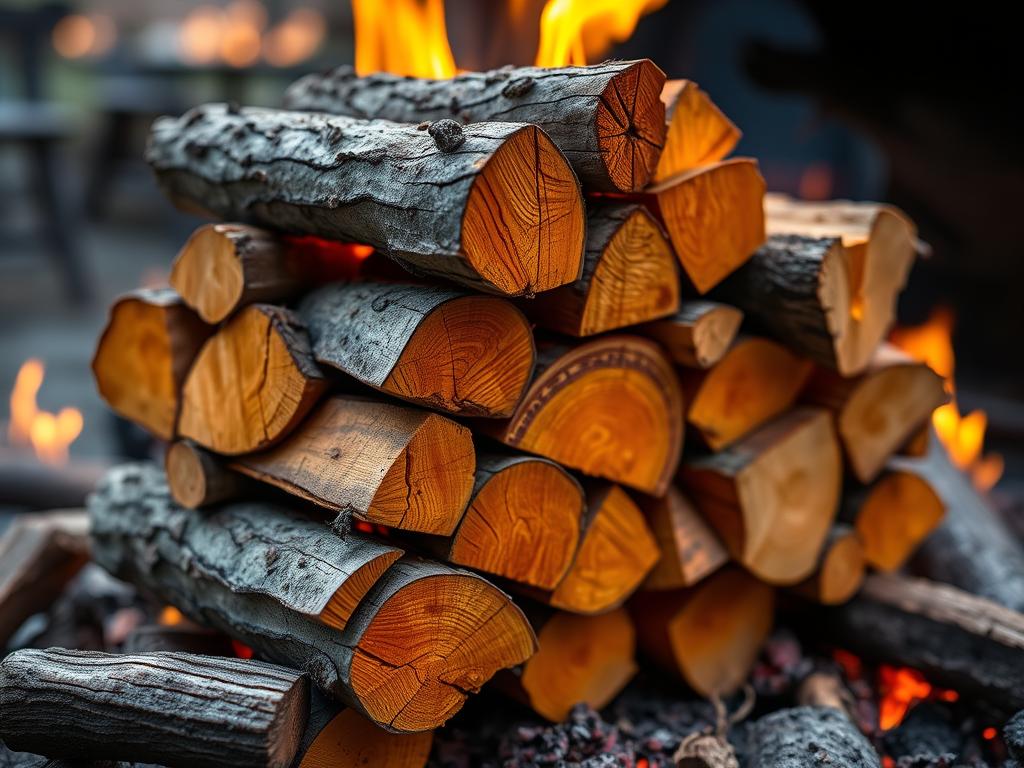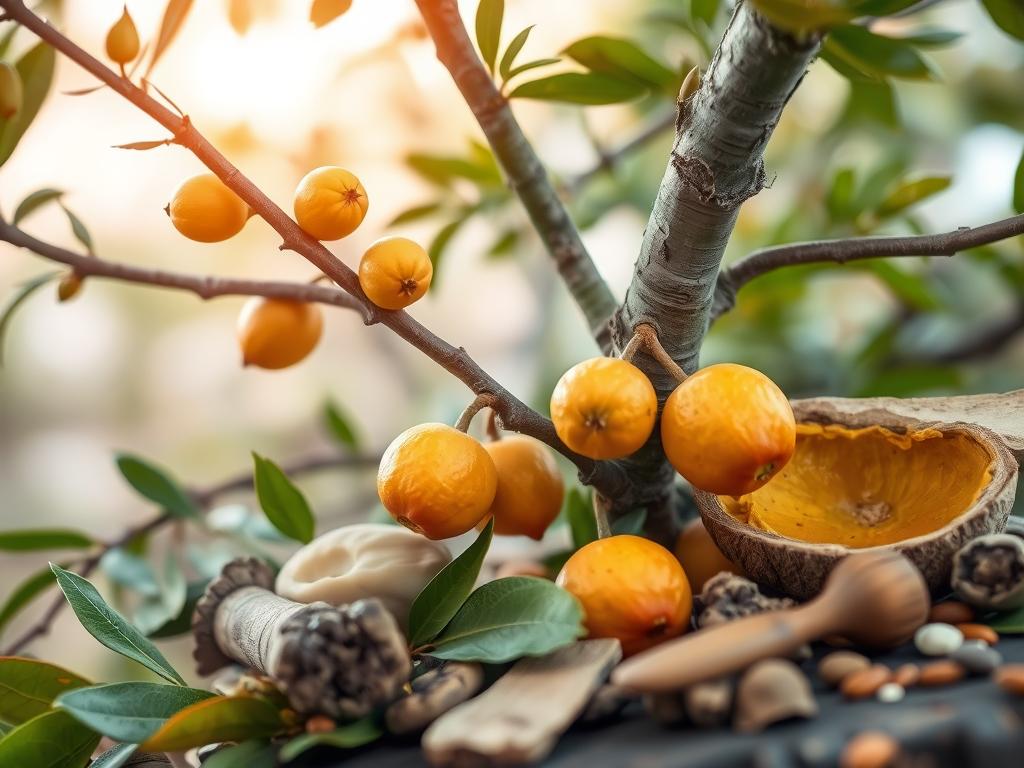
Osage Orange Wood: 7 Surprising Facts You’ll Love

Did you know over 200 million Osage orange trees were planted as windbreaks in the 1930s? By 1942, they covered more than 18,000 miles. This shows how useful this tree is. The tree is known as Maclura pomifera and its wood has many uses.
Osage orange wood is loved for its natural pest repellent qualities. It’s also very durable, resisting rot and insects well. This makes it great for firewood and outdoor furniture. It’s also a key part of American history, used to make the famous osage orange bow.
Its strength and unique qualities make it a top choice for crafts and building. This proves its value in many areas.
Table of Contents
What is Osage Orange Wood
Osage orange wood, known as Maclura pomifera, has a deep history in the South-Central United States. It’s known for its hardness and resistance to decay. This makes it very popular for different uses.
The wood is very dense and bright yellow. It’s often compared to traditional hardwoods because of these traits.
The Osage orange tree can grow up to 50 feet tall. Its crown can spread up to 60 feet wide. Female trees need male pollinators to produce fruit, which is four to six inches in diameter. This fruit is not edible to humans but is crucial for the tree’s reproduction.
For a long time, indigenous peoples used Osage orange wood to make archery bows. Its strength and durability made it ideal for this purpose. This shows how important Osage orange wood is, not just for its uses but also for the cultures that relied on it.

Natural Pest Repellent Properties
The Osage orange tree is known for its natural pest repellent. This is thanks to tetrahydroxystilbene in its fruit. But, it’s important to understand how it works and its practical uses for pest control.
How Tetrahydroxystilbene Works
Tetrahydroxystilbene keeps away insects like ants, crickets, and boxelder bugs. Yet, the fruit itself doesn’t work as well as concentrated extracts. This has led to confusion about using Osage oranges for pest control.
Application Methods for Pest Control
Here are some ways to use Osage oranges for pest control:
- Put halved Osage orange fruits in places where pests are a problem, like gardens and doorways.
- Check if it works by seeing how the fruit breaks down and releases the repellent.
- Consider using strong extracts if you need a more effective repellent.
Using Osage oranges for pests is a natural choice instead of chemical pesticides. But, it’s important to know what research says about its effectiveness.
Wildlife Habitat and Ecological Importance
The osage orange tree, or Maclura pomifera, is a key part of the ecosystem. Its thorny branches and dense foliage offer a safe home for birds and small mammals. This helps support a wide range of plants and animals, boosting biodiversity.
Providing Shelter for Birds and Animals
The osage orange tree’s dense growth makes it a perfect shelter for wildlife. Its thorns keep out big predators, and its leaves protect against bad weather. The tree also produces fruit that attracts birds and small animals, adding to the local food web.
Role in Local Ecosystems
The osage orange tree is vital to local ecosystems. Its deep roots help prevent soil erosion, keeping the soil stable. It grows well in many soils and can survive long droughts. By supporting other plants and keeping moisture levels up, it helps maintain a healthy environment.
| Feature | Description |
|---|---|
| Height | Averages 58%, showing growth potential. |
| Root System | Lateral radii of 4.3 meters (14 feet) and depths over 8.2 meters (27 feet) in shelterbelts. |
| Fruit Production | Female trees produce abundant fruit, mainly softballs in size, with no seeds when no male trees are nearby. |
| Germination Rate | Averages 58%, showing potential for growth. |
| Climate Adaptability | Thrives in zones 5-9 and tough climatic conditions. |
Durability and Strength of Osage Orange Wood
Osage orange wood is known for its amazing durability and strength. It’s a top pick for many woodworking projects. This wood resists decay and insects well.
Its physical qualities make it great for many uses. It ensures long-lasting and reliable results.
Rot and Insect Resistance
The wood’s rot resistant properties are perfect for outdoor use. It’s also great at fighting off pests and moisture. This makes it safe for:
- Fence posts
- Railway ties
- Agricultural rails and gate posts
Its high density, at 0.93, adds to its strength. It can hold up to 293 Kg before breaking, which means structures made from it last longer and require less upkeep.
Uses in Construction and Craftsmanship
Woodworkers love osage orange for making beautiful furniture. Its colors range from golden yellow to deep orange. This makes high-end items like:
- Tables
- Chairs
- Cabinets
Artisans also use it for unique projects. Its turning properties are great for making bowls, pens, and ornaments. The wood’s hardness and density help protect these items from damage.
Overall, osage orange wood is a smart choice for both building and art. It combines function with beauty. Its qualities make it a sustainable and attractive option for many uses.
Osage Orange Wood Uses in Archery
Osage orange wood is key in archery, known for its excellent qualities. It’s perfect for making bows because of its flexibility and strength. The Osage Nation has used it for both practical and cultural reasons.
Making Bows: Osage Orange Bow
The osage orange bow shows the skill of traditional bow making. Made from osage orange wood, these bows are strong and look great. Their density helps archers hit their mark better.
Choosing the right wood is crucial. It must be cured just right to last long and perform well.
Historical Significance in Indigenous Cultures
Osage orange wood’s history goes beyond just making tools. It was vital for the Osage Nation’s survival and culture. This wood symbolized their connection to the land and their ability to adapt.
| Aspect | Details |
|---|---|
| Origin | Arkansas, southeastern Oklahoma, east Texas |
| Properties | Heavy, slightly harder than mesquite, 50% harder than hickory |
| Pricing | Moderate to high due to limited availability |
| Bow Crafting | Optimal for bending operations, powerful draw characteristics |
| Cultural Significance | Integral to the Osage Nation’s way of life and identity |
Firewood Characteristics of Osage Orange
Osage orange firewood is known for its high heat output. It releases 32.9 million BTUs per cord, beating many other firewoods. This makes it great for heating homes.
The wood’s density leads to long-lasting burns. This is a big plus for heating.

High Heat Output and Benefits
The high heat of osage orange firewood offers many benefits. It burns more efficiently than other hardwoods, saving time and effort. It also sparks well, perfect for starting fires.
This firewood is perfect for keeping warm in cold seasons.
Best Practices for Using as Firewood
Using osage orange firewood right means it should be well-seasoned. Seasoning it properly prevents popping and smoke. It also makes the fire safer and more efficient.
Knowing how to use this wood well can make your fire burning experience better.
Low Maintenance Gardening Benefits
Osage orange trees are great for low maintenance gardening. They grow well in many soils. This makes them a top pick for gardeners who want tough plants.
Drought Resistance and Hardy Nature
These trees are perfect for saving water. They can handle dry spells and only need a good soaking once a week. Their strong nature lets them thrive in tough conditions, fitting well with minimal care gardening.
Minimal Care Requirements
Osage orange care is easy, letting homeowners enjoy their gardens with little work. They fight off many pests and diseases, so you don’t need to use harsh chemicals. Growing up to three feet a year, they handle pollution and road salt well. For those who want to garden with less effort, osage orange trees offer beauty and function without hard work.
Medicinal Uses and Historical Significance
The Osage orange tree has a long history in native american herbal medicine. Its wood, bark, and fruit were used for health benefits. Native Americans used it to treat many illnesses.
Traditional Native American Applications
Native American tribes used the osage orange in their medicine. The bark was used for dyes and tannins. Seeds from the fruit fed birds and small mammals.
The tree’s healing properties were well-known by indigenous peoples. This led to more research on its medicinal uses.
Modern Research on Medicinal Properties
Today, scientists are studying the osage orange. They found compounds with health benefits. One compound, pomiferin, has antioxidant properties.
This research could help with cancer and fungal infections. It shows the osage orange’s value in modern health products. These findings make the tree even more interesting for its healing properties.

Artistic Uses of Osage Orange Wood
Osage orange wood is a favorite among craftsmen for its artistic potential. It’s known for its unique density and beauty. This makes it perfect for musical instruments and decorative items. Let’s explore how this wood adds a special touch to art.
Crafting Musical Instruments
Osage orange wood is highly valued for making musical instruments. Its dense nature ensures great sound quality. This makes it ideal for woodwind and string instruments.
Luthiers love its hardness and sound properties. They can create instruments that look and sound amazing. The wood’s rich color and grain make it even more appealing.
Woodturning and Decorative Projects
Woodturning with Osage orange is both challenging and rewarding. Craftsmen use it for bowls, mallets, and furniture. Its toughness requires tools to be sharpened often, but the results are worth it.
Finishing techniques like Rubio Monocoat or boiled linseed oil highlight its beauty. They bring out intricate designs. Woodworkers share stories of both struggles and successes with osage orange, proving its worth in crafting.
Conclusion
Osage orange wood is known for its many uses and benefits. It’s durable and has beautiful colors, making it great for furniture. Its natural strength also makes it perfect for turning into bowls, pens, and other decorative items.
This wood has a rich history, too. It was used by Indigenous tribes for making bows. Today, it’s also used for tool handles and fencing, showing its practical side. As more people learn about its benefits, it’s becoming a key part of sustainable woodworking.
In short, Osage orange wood is both functional and beautiful. It’s a key player in eco-friendly practices. By using it in various projects, we help preserve it for the future. We also celebrate its history and usefulness.
FAQs
What is osage orange wood, and what are its key characteristics?
Osage orange wood comes from the Maclura pomifera tree. It’s known for its strength, durability, and yellow-orange color. It’s also resistant to decay, making it great for woodworking, archery, and outdoor projects.
How does osage orange function as a natural pest repellent?
The osage orange tree has a compound called tetrahydroxystilbene. This compound repels pests like ants and crickets. You can use halved fruits in your garden to keep pests away without using chemicals.
What makes osage orange wood suitable for archery?
Osage orange wood is perfect for archery because it’s flexible and durable. It’s used to make traditional bows, known as osage orange bows. Its unique qualities help create strong and reliable archery equipment.
What ecological benefits do osage orange trees provide?
Osage orange trees help prevent soil erosion and support wildlife. They provide habitat and nesting sites for birds and small mammals. This enhances the local flora and fauna.
How can osage orange wood be utilized as firewood?
Osage orange wood burns hot and efficiently. It’s great for long-lasting fires. But, be careful to avoid too much smoke and damage to your fireplace.
What are the low maintenance advantages of osage orange trees?
Osage orange trees need little care and can thrive in different conditions, including dry ones. They’re resistant to many pests and diseases. This makes them easy to care for and good for the environment.
What medicinal uses are associated with Osage orange?
Osage orange has been used in traditional medicine by Native Americans. Modern research is looking into its health benefits. It may help with cancer and fungal infections, showing its potential as a natural remedy.
Can Osage orange wood be used for artistic purposes?
Yes, Osage orange wood is great for crafts like woodturning and making musical instruments. It has excellent sound quality and can be finished beautifully. This makes it perfect for creating intricate designs and beautiful pieces.



